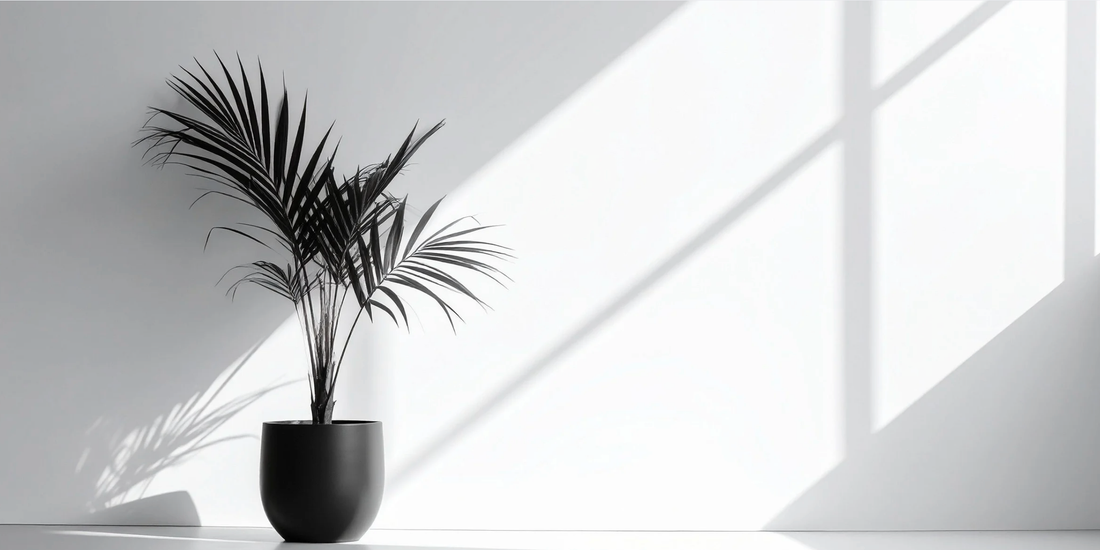Getting plant lighting right can be confusing, but it doesn’t have to be. If your plants are looking dull, stretching toward windows, or not growing much, lighting is probably the reason. In this guide, we’ll break down everything you need to know about the different kinds of light and which plants thrive in each.
Why Light Matters
Light is food for plants. Without it, your plants can’t make the energy they need to grow and stay healthy. Many new plant parents worry about watering and soil, but light is often the real reason plants struggle.
The right light determines how fast your plant grows, how vibrant its leaves are, and even how much water it needs. Too little light can make plants stretch and lose color. Too much light can scorch leaves or cause dry, crispy edges.
The Four Main Types of Light
1. Bright Direct Light
Bright direct light means sunlight is hitting the leaves directly for several hours a day. South-facing and west-facing windows often provide this kind of light. These areas are ideal for plants that naturally grow in sunny, open spaces.
Plants that love bright direct light include cacti, succulents, and sun-loving tropicals. If the light is too intense, you can diffuse it with a sheer curtain or move the plant a few inches away from the window.
2. Bright Indirect Light
Bright indirect light means the room is very well lit, but the sun doesn’t touch the plant directly. This is the most common and ideal lighting for tropical houseplants that naturally grow under tree canopies in the wild.
Plants that thrive in bright indirect light include monsteras, philodendrons, calatheas, and many varieties of ferns. Most tropical plants you find in shops will prefer this type of lighting.
3. Medium Light
Medium light refers to areas that are still bright but don’t receive direct sun. These spots might be a few feet away from a bright window or near an east-facing window with gentle morning sun.
Plants that do well in medium light include pothos, peace lilies, and spider plants. These species tolerate a variety of conditions and are great for living rooms and offices that get natural daylight but not harsh rays.
4. Low Light
Low light areas are spaces where there is daylight, but no direct sunlight and limited brightness. A room with smaller windows or north-facing exposure often provides this type of light.
Low light doesn’t mean no light. Completely dark rooms without windows are not suitable for any plant. However, some plants are extremely tolerant of dim conditions. These include snake plants, ZZ plants, and aglaonemas.
If your plant’s leaves start losing color or it stops growing, it may not be getting enough light.
How to Identify Light Levels in Your Home
You don’t need special equipment to understand your light levels. A simple test is to notice the shadows in your space. Strong, defined shadows mean direct light. Soft, blurry shadows mean indirect light. Faint or no shadows mean low light.
Light also changes with the seasons. Summer sun is stronger and lasts longer, while winter light is weaker and shorter. If you move your plants seasonally, they can stay in their ideal lighting year-round.

Matching Plants to Your Space
If you have a sunny window that gets direct afternoon light, consider succulents or cacti.
If your space is bright but your plant won’t get direct rays, choose tropicals like philodendrons or monsteras.
If you’re working with moderate light, go for a pothos or spider plant.
If your space is dim or mostly shaded, choose tough survivors like the ZZ plant or snake plant.
When you pair the right plant with the right light, everything else becomes easier—watering, feeding, and keeping your plant looking great.
Common Lighting Mistakes
-
Placing low-light plants in bright direct sun can burn the leaves.
-
Putting sun-loving plants too far from windows causes leggy, pale growth.
-
Assuming all windows give the same light level. South and west windows are the strongest, while north windows are weakest.
-
Forgetting that light drops sharply just a few feet away from a window.
Related Reading
Once you’ve figured out lighting, the next step is learning how to keep your plants healthy through proper watering and care. Be sure to read our blog “How to Water Houseplants: The Ultimate Guide for Beginners and Beyond” to learn how light and water work together.
If your space has darker corners, check out our post “Low-Light Houseplants: What ‘Low Light’ Really Means (and What Actually Thrives)” to find the perfect plants for those areas.
Final Thoughts
Understanding your home’s lighting is one of the easiest ways to keep your houseplants thriving. Once you know where the bright, medium, and low-light spots are, you can confidently choose plants that match your space and lifestyle.
At Urbane Eight, we offer a variety of plants suited for every lighting condition, along with potting mixes and care products designed to help them grow strong and healthy.




